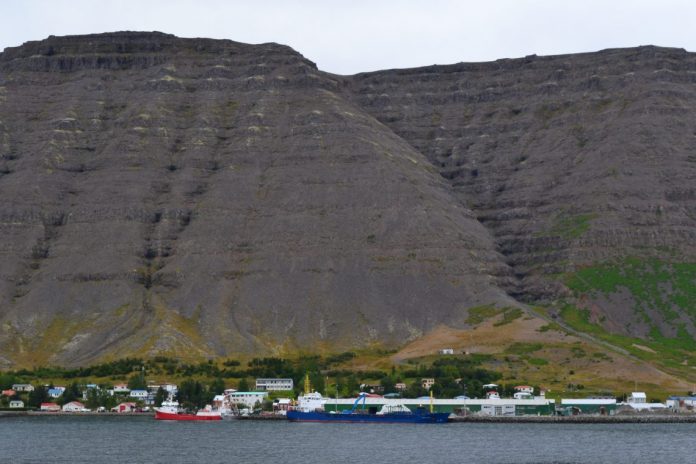When Arnarlax was established in 2009 at Bíldudalur in the Westfjords, both the petrol station and the local school were on the verge of being closed down. Now, almost ten years later, thanks largely to the salmon producer, there is renewed optimism in the settlement.
The drive from Reykjavik to Bíldudalur takes around five hours, if you are lucky with the weather and wind. Combined with – at times – winding roads, it’s somewhat of a challenge to get to one’s destination by car. Countless horses and sheep can be seen as we drive along the road to the west, and even when we pass the airport that lies less than ten kilometres from the settlement of Bíldudalur, there is little to indicate that Iceland’s biggest salmon producer lies nearby.

But then, quite unexpectedly, we spy some farm cages in the sea. Shortly after, around a bend, Bíldudalur suddenly appears on the other side of bay. A few minutes later, SalmonBusiness has arrived in the settlement.
On the way to the wharf, where Arnarlax has its offices and harvest plant, we pass a school and a petrol station. “There’s life in the village” as the saying goes. It’s a clear but chilly autumn day when we are welcomed by Kristian Matthiasson, the Norwegian-Icelander who heads Arnarlax. There is opposition to fish farming on Iceland, but the situation is quite another in Bíldudalur, according to Matthiasson.
“Here it’s entirely positive, and people here realise the importance of what we are doing. Bíldudalur was a dying village. It’s not that many years since they were considering closing both the school and the petrol station. That would have hammered the last two nails in the coffin for this place here. Then it would have been over and out,” said Matthiasson, who together with his father Matthias Gardarsson decided to do something about it. His father in particular, who was born and brought up in the settlement, feared for Bíldudalur’s future.

Potential
That’s why the two of them started “Project Iceland”. This happened at the same time as father and son were living in Norway, and were granted two licenses through the company Salmus Akva in Nordland County in 2009 – the year after Arnarlax was established.
“At the same time as we applied in Norway, we started a process on Iceland. We saw the settlement was “on its last legs”, and rural settlements were particularly vulnerable when the finance crisis hit Iceland. It was unbelievably sad to see the homeplace die out. Knowing full well what the salmon had done in Norway, changing the fortunes of small, local communities, we saw the same potential for that here in Bíldudalur”.

Arnarlax was awarded a license in 2012, and purchased an old Arctic char depot, in which they began producing smolt. The first fish were released into marine cages in 2014.
Nowadays, the company’s ambition is clear:
“We hope to create a tiny Frøya here in the Westfjords,” said Mattiasson, with obvious reference to SalMar, which owns 40 percent of the shares in Arnarlax.
– Shaped a future for many
Since Arnarlax started up, 80 people have moved to the settlement.
“There’s been huge growth, and people are moving back, highly educated people. These are folk with comprehensive resources that are helping this community to get back on its feet again,” said Matthiasson, while offering examples of how life has improved.
“People look after and maintain their dwellings, and themselves. They’re beginning to think about their health. Thinking about one’s health means they see a future here. With Arnarlax in Bíldudalur we have created a future here for a lot of people,” said Matthiasson.

Many of those who have moved to the settlement, primarily East Europeans, work in the slaughter plant. Matthiasson said that the greatest challenge so far at the harvest plant, has been with transfer procedures, including when they lost 200,000 fish in February through transferring fish in low temperatures.
“It has resulted in lower volume, and there has been a lot of stopping and starting. It hasn’t been possible to run a stable production over a longer period, and that has caused costs to be higher than they should be”.
According to Mathiasson, no one has been laid off, but Iceland hasn’t any arrangement for redundancies/lay-offs.
“We find other tasks for workers at the slaughter plant when production is interrupted,” said Matthiasson.

The company has invested in enhancing life here for the new employees, by among other things, building a golf course, fitness studio, buying a snow cat for skiing, started an athletics school and established bus routes to neighbouring settlements.
“If we don’t have a local environment, we don’t have Arnarlax. That’s why these investments are so important,” concluded Matthiasson.



